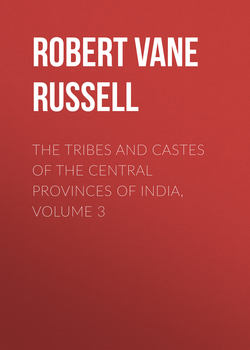Читать книгу The Tribes and Castes of the Central Provinces of India, Volume 3 - Robert Vane Russell - Страница 23
Gond
(a) Origin and History
5. Mythica traditions. Story of Lingo
ОглавлениеMr. Hislop took down from a Pardhān priest a Gond myth of the creation of the world and the origin of the Gonds, and their liberation from a cave, in which they had been shut up by Siva, through the divine hero Lingo. General Cunningham said that the exact position of the cave was not known, but it would seem to have been somewhere in the Himalayas, as the name Dhawalgiri, which means a white mountain, is mentioned. The cave, according to ordinary Gond tradition, was situated in Kachikopa Lohāgarh or the Iron Valley in the Red Hill. It seems clear from the story itself that its author was desirous of connecting the Gonds with Hindu mythology, and as Siva’s heaven is in the Himalayas, the name Dhawalgiri, where he located the cave, may refer to them. It is also said that the cave was at the source of the Jumna. But in Mr. Hislop’s version the cave where all the Gonds except four were shut up is not in Kachikopa Lohāgarh, as the Gonds commonly say; but only the four Gonds who escaped wandered to this latter place and dwelt there. And the story does not show that Kachikopa Lohāgarh was on Mount Dhawalgiri or the Himalayas, where it places the cave in which the Gonds were shut up, or anywhere near them. On the contrary, it would be quite consonant with Mr. Hislop’s version if Kachikopa Lohāgarh were in the Central Provinces. It may be surmised that in the original Gond legend their ancestors really were shut up in Kachikopa Lohāgarh, but not by the god Siva. Very possibly the story began with them in the cave in the Iron Valley in the Red Hill. But the Hindu who clearly composed Mr. Hislop’s version wished to introduce the god Siva as a principal actor, and he therefore removed the site of the cave to the Himalayas. This appears probable from the story itself, in which, in its present form, Kachikopa Lohāgarh plays no real part, and only appears because it was in the original tradition and has to be retained.45 But the Gonds think that their ancestors were actually shut up in Kachikopa Lohāgarh, and one tradition puts the site at Pachmarhi, whose striking hill scenery and red soil cleft by many deep and inaccessible ravines would render it a likely place for the incident. Another version locates Kachikopa Lohāgarh at Dārekasa in Bhandāra, where there is a place known as Kachagarh or the iron fort. But Pachmarhi is perhaps the more probable, as it has some deep caves, which have always been looked upon as sacred places. The point is of some interest, because this legend of the cave being in the Himalayas is adduced as a Gond tradition that their ancestors came from the north, and hence as supporting the theory of the immigration of the Dravidians through the north-west of India. But if the view now suggested is correct, the story of the cave being in the Himalayas is not a genuine Gond tradition at all, but a Hindu interpolation. The only other ground known to the writer for asserting that the Gonds believed their ancestors to have come from the north is that they bury their dead with the feet to the north. There are other obvious Hindu accretions in the legend, as the saintly Brāhmanic character of Lingo and his overcoming the gods through fasting and self-torture, and also the fact that Siva shut up the Gonds in the cave because he was offended by their dirty habits and bad smell. But the legend still contains a considerable quantity of true Gond tradition, and though somewhat tedious, it seems necessary to give an abridgment of Mr. Hislop’s account, with reproduction of selected passages. Captain Forsyth also made a modernised poetical version,46 from which one extract is taken. Certain variations from another form of the legend obtained in Bastar are included.
45
The argument in this section will be followed more easily if read after the legend in the following paragraphs.
46
Highlands of Central India (Chapman & Hall).
